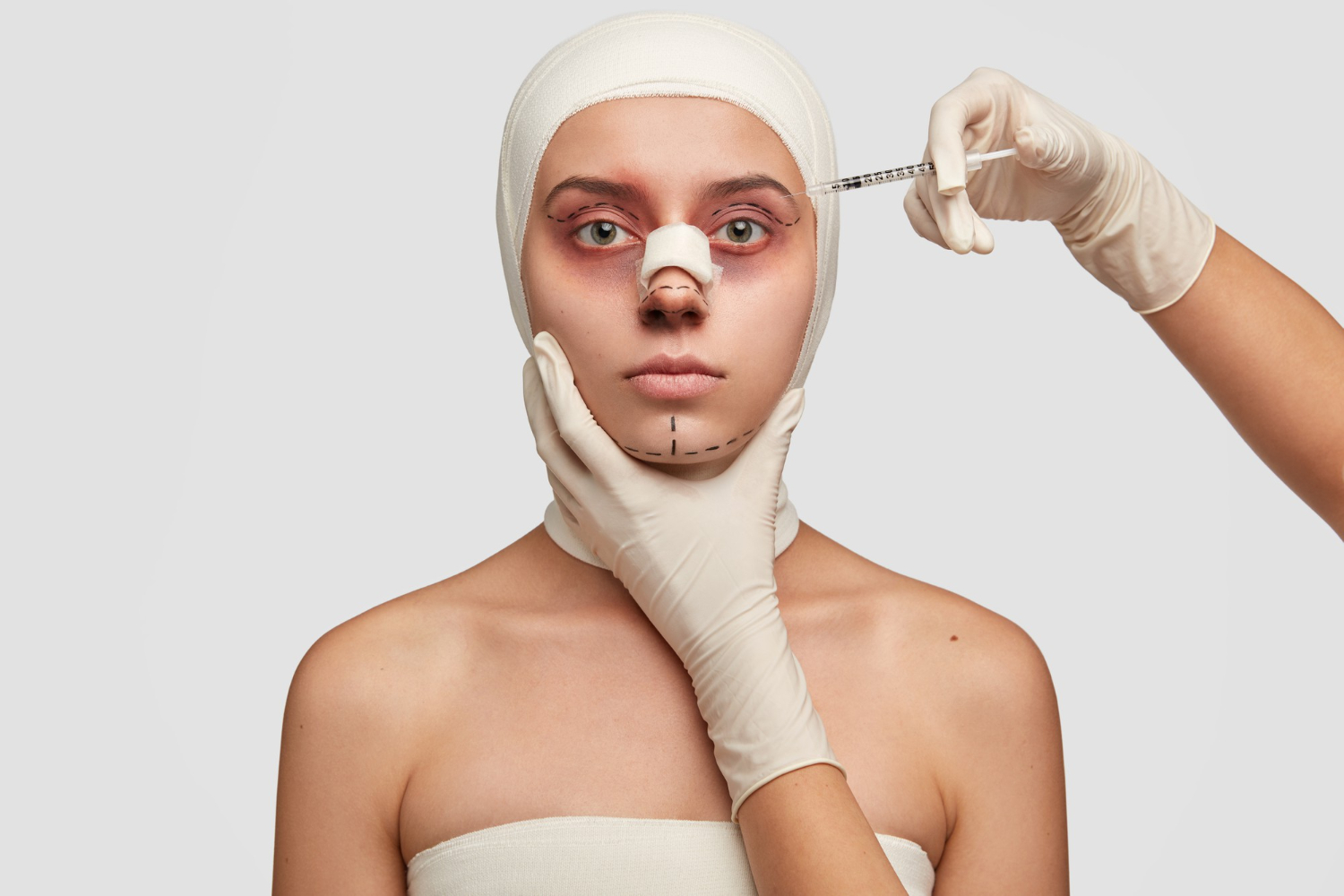Rhinoplasty, sometimes known as a “nose job,” is a surgical treatment that reshapes and improves the look of the nose. It’s one of the most common cosmetic operations since it may solve both aesthetic and functional issues with the nose. Here’s a rundown of rhinoplasty, including its aims, technique, recuperation, and considerations:
Goals of Rhinoplasty
Aesthetic Enhancement:
Rhinoplasty can change the size, shape, and proportions of the nose to create a more balanced and harmonious facial look. It can treat dorsal hump, nasal breadth, tip form, nostril size, and overall symmetry.
Functional Improvement:
Rhinoplasty can fix structural abnormalities that impact breathing, such as a deviated septum or nasal valve collapse, in some circumstances. This procedure is called as functional rhinoplasty or septoplasty.

Types of Rhinoplasty
Open Rhinoplasty:
A tiny incision is made across the columella (the tissue between the nostrils) to provide the surgeon with with better access to the nose’s underlying components. This approach is frequently employed in difficult circumstances since it allows for exact modifications.
Closed Rhinoplasty:
Incisions are done inside the nostrils for closed rhinoplasty, resulting in no visible scars. This method is appropriate for less severe alterations and provides a faster recovery period.
Rhinoplasty Procedure
Consultation:
You will discuss your objectives, concerns, and expectations for the procedure during your initial consultation with a board-certified plastic surgeon. To establish your appropriateness for the treatment, the surgeon will examine your face characteristics, nasal structure, and overall health.
Surgery:
You will be sedated on the day of surgery to guarantee your comfort during the process. The surgical incisions will be made, the nasal bones and cartilage will be reshaped, and the incisions will be sutured closed.
Recovery:
Rest and recuperation are required following surgery. During the first healing phase, swelling, bruising, and minor pain are usual. Most patients may resume modest activities after a week, but edema might take several weeks to reduce entirely.
Considerations and Recovery
Realistic Expectations:
It is critical to have realistic expectations for the outcome of rhinoplasty. While the operation can result in considerable improvements, no surgery can promise perfection or the precise duplication of a perfected picture.
Recovery Period:
The early healing phase includes some soreness, edema, and bruising. Swelling can take several weeks to reduce completely, and the ultimate effects may not be seen for several months.
Post-Operative Care:
Carefully follow your surgeon’s post-operative recommendations. This might include refraining from intense activity, not blowing your nose, and keeping your head high.
Results:
Rhinoplasty outcomes are typically long-lasting, however the final result may take some time to completely appear as the healing process proceeds.
Scarring:
A minor external scar across the columella may be evident after open rhinoplasty. However, this scar usually disappears and becomes unobtrusive with time.
Consultation:
It is critical to select an experienced, board-certified plastic surgeon in order to get safe and happy outcomes. Discuss your objectives, concerns, and any questions you have regarding the surgery during your consultation.
Candidate Considerations
Age:
Rhinoplasty is often indicated for those who have completed their face development, which happens in their late teens or early twenties. However, age is not the only thing to consider; general health, emotional maturity, and realistic expectations are all crucial.
Health:
A good general state of health is required for a successful operation and recovery. During the appointment, discuss any pre-existing medical problems and drugs with your surgeon.
Communication:
It is critical to have open and clear communication with your surgeon. Clearly express your surgical objectives, concerns, and expectations. Your surgeon can explain what is possible and provide recommendations depending on your facial shape.
Customization
Individualized Approach:
Because no two noses are alike, a professional surgeon will tailor the operation to obtain results that match your own facial characteristics.
Computer Imaging:
During consultations, some surgeons employ computer imaging to model prospective post-surgery outcomes. This might assist you and your surgeon in aligning your expectations and visualizing the possible changes.
Aesthetic Changes
Nasal Bridge:
To obtain a smoother profile, a dorsal hump (a bulge on the bridge of the nose) might be removed.
Nasal Tip:
To get the desired look, the nasal tip might be polished, reshaped, raised, or rotated.
Nostrils:
The nostrils’ size and shape can be altered for better symmetry and balance.
Nasal Length:
You may change the length of your nose by altering the location of the tip relative to your upper lip.
Functional Rhinoplasty:
Functional Rhinoplasty can help with breathing problems caused by a deviated septum or other structural abnormalities. This style of rhinoplasty is concerned with both appearance and function.
Revisions and Secondary Rhinoplasty
Revision Rhinoplasty:
Sometimes, a patient may be dissatisfied with the results of their initial rhinoplasty or experience complications. Revision rhinoplasty is a corrective procedure that aims to address the concerns from the first surgery.
Complex Cases:
Secondary rhinoplasty can be more complex due to scar tissue and changes in the nasal anatomy. It’s important to choose a surgeon experienced in both primary and revision rhinoplasty.
Recovery and Results
Swelling:
Swelling is a normal aspect of the healing process and might last several weeks or months. The ultimate benefits of rhinoplasty may not be entirely visible until the swelling goes down.
Patience:
Be patient during the recuperation process. Healing differs from person to person, and it is critical to give your body the time it requires to recover correctly.
Choosing a Surgeon
Certification:
Look for a board-certified plastic surgeon with advanced training and experience in face and rhinoplasty surgeries.
Portfolio:
Look through the surgeon’s before-and-after images to get a sense of their approach and the outcomes they’ve achieved with past patients.
Consultations:
Meet with several surgeons to discuss your objectives, assess their skills, and ask questions about their approach to rhinoplasty.

